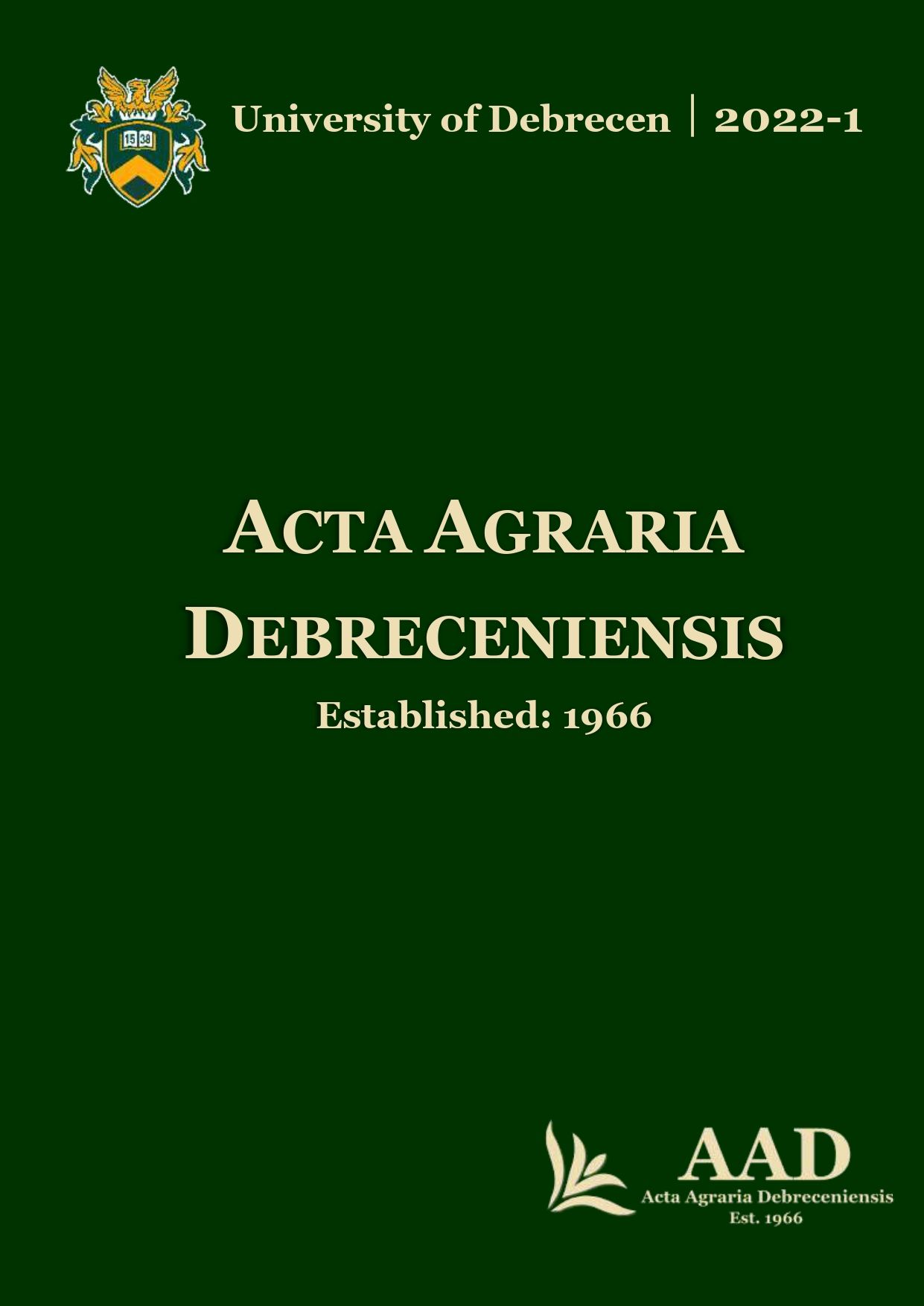Microgreen leaf vegetable production by different wavelengths
Authors
View
Keywords
License
Copyright (c) 2022 by the Author(s)

This work is licensed under a Creative Commons Attribution 4.0 International License.
How To Cite
Accepted 2022-04-21
Published 2022-05-26
Abstract
Microgreens are becoming more popular in gastronomy, especially as a salad ingredient. In this study, two plant species belonging to the cabbage family were grown as microgreens, namely red cabbage and broccoli. Three different light-emitting diodes (LEDs) were used in the experiment, blue, red, and combined (blue:red) lighting. The experiment was carried out by 118 µmol-2 s-1total Photosynthetic Photon Flux (PPF), LED lighting was applied for 16 hours a day. Blue light primarily stimulates leaf growth, while red light promotes flowering. In our experiment, blue and combined lighting favorably affected plant development, yield (~3000 g m-2), chlorophyll-a (~8.0 mg g-1), and carotenoid content (9.0 mg g-1). However, the red light resulted in reduced harvest yields (~2200 g m-2), chlorophyll-a (~6.0 mg g-1), and carotenoid content (~7.0 mg g-1). The development of red cabbage was favorably influenced by the blue spectrum, while the combined spectrum favorably influenced the development of broccoli.
References
- Brazaitytė, A.–Miliauskienė, J.–Vaštakaitė-Kairienė, V.–Sutulienė, R.–Laužikė, K.–Duchovskis, P.–Małek, S. (2021): Effect of Different Ratios of Blue and Red LED Light on Brassicaceae Microgreens under a Controlled Environment. Plants, 10(4), 801.
- Brazaitytė, A.–Viršilė, A.–Samuolienė, G.–Jankauskienė, J.–Sakalauskienė, S.–Sirtautas, R.–Novičkovas, A.–Dabašinskas, L.–Vaštakaite V.–Miliauskienė, J.–Duchovskis, P. (2016): Light quality: growth and nutritional value of microgreens under indoor and greenhouse conditions. In VIII International Symposium on Light in Horticulture 1134 pp. 277–284.
- Bulgari, R.–Baldi, A.–Ferrante, A.–Lenzi, A. (2017). Yield and quality of basil, Swiss chard, and rocket microgreens grown in a hydroponic system. New Zealand Journal of Crop and Horticultural Science, 45(2), 119–129. doi:10.1080/01140671.2016.1259642
- Cope, K.R.–Snowden, M.C.–Bugbee, B. (2014): Photobiological interactions of blue light and photosynthetic photon flux: Effects of monochromatic and broad‐spectrum light sources. Photochemistry and photobiology, 90(3), 574–584 doi:10.1111/php.12233
- Di Gioia, F.–Petropoulos, S.A.–Ozores-Hampton, M.–Morgan, K.–Rosskopf, E.N. (2019): Zinc and iron agronomic biofortification of Brassicaceae microgreens. Agronomy, 9(11), 677. doi:10.3390/agronomy9110677
- Kowitcharoen, L.–Phornvillay, S.–Lekkham, P.–Pongprasert, N.–Srilaong, V. (2021): Bioactive Composition and Nutritional Profile of Microgreens Cultivated in Thailand. Applied Sciences, 11(17), 7981. doi:10.3390/app11177981
- Le, T.N.–Chiu, C.H.–Hsieh, P.C. (2020): Bioactive compounds and bioactivities of Brassica oleracea L. var. italica sprouts and microgreens: An updated overview from a nutraceutical perspective. Plants, 9(8), 946. doi:10.3390/plants9080946
- Li, Y.–Xin, G.–Wei, M.–Shi, Q.–Yang, F.–Wang, X. (2017): Carbohydrate accumulation and sucrose metabolism responses in tomato seedling leaves when subjected to different light qualities. Scientia Horticulturae, 225, 490–497. doi:10.1016/j.scienta.2017.07.053
- Moran, R.–Porath, D. (1980): Chlorophyll determination in intact tissues using N, N-dimethylformamide. Plant Physiology, 65(3), 478–479.
- Mir, S.A.–Shah, M.A.–Mir, M.M. (2017): Microgreens: Production, shelf life, and bioactive components. Critical reviews in food science and nutrition, 57(12), 2730–2736. doi:10.1080/10408398.2016.1144557
- Palmitessa, O.D.–Renna, M.–Crupi, P.–Lovece, A.–Corbo, F.–Santamaria, P. (2020): Yield and quality characteristics of Brassica microgreens as affected by the NH4: NO3 molar ratio and strength of the nutrient solution. Foods, 9(5), 677. doi:10.3390/foods9050677
- Paradiso, V.M.–Castellino, M.–Renna, M.–Leoni, B.–Caponio, F.–Santamaria, P. (2018a): Simple tools for monitoring chlorophyll in broccoli raab and radish microgreens on their growing medium during cold storage. Prog. Nutr, 20, 1–8. doi:10.23751/pn.v20i3.7097
- Paradiso, V.M.–Castellino, M.–Renna, M.–Gattullo, C. E.–Calasso, M.–Terzano, R.–Allegretta, I.–Leoni, B.–Caponio, F.–Santamaria, P. (2018b): Nutritional characterization and shelf-life of packaged microgreens. Food & function, 9(11), 5629–5640. doi:10.1039/c8fo01182f
- Renna, M.–Di Gioia, F.–Leoni, B.–Mininni, C.–Santamaria, P. (2017): Culinary assessment of self-produced microgreens as basic ingredients in sweet and savory dishes. Journal of
- culinary science & technology, 15(2), 126–142. doi:10.1080/15428052.2016.1225534
- Su, N.–Wu, Q.–Shen, Z.–Xia, K.–Cui, J. (2013): Effects of light quality on the chloroplastic ultrastructure and photosynthetic characteristics of cucumber seedlings. Plant Growth Regulation, 73 (3), 227–235. doi:10.1007/s10725-013-9883-7
- Toscano, S.–Cavallaro, V.–Ferrante, A.–Romano, D.–Patané, C. (2021): Effects of different light spectra on final biomass production and nutritional quality of two microgreens. Plants, 10(8), 1584. doi:10.3390/plants10081584
- Turner, E.R.–Luo, Y.–Buchanan, R.L. (2020): Microgreen nutrition, food safety, and shelf life: A review. Journal of food science, 85(4), 870–882. doi:10.1111/1750-3841.15049
- Vaštakaitė, V.–Viršilė, A. (2015): Light-emitting diodes (LEDs) for higher nutritional quality of Brassicaceae microgreens. In Annual 21st International Scientific Conference:" Research for Rural Development" Volume 1, Jelgava, Latvia, 13–15 May 2015. Latvia University of Agriculture. pp. 111–117.
- Widiwurjani,–Guniart,–Sari, N.K.–Andansari, P. (2020): Microgreen Quality of Broccoli Plants (Brassica oleracea L.) and Correlation between Parameters. In Journal of Physics: Conference Series Vol. 1569, No. 4, p. 042093. doi:10.1088/1742-6596/1569/4/042093
- Xiao, Z.–Lester, G.E.–Luo, Y.–Wang, Q. (2012): Assessment of vitamin and carotenoid concentrations of emerging food products: edible microgreens. Journal of agricultural and Food Chemistry, 60(31), 7644-7651. doi:10.1021/jf300459b
- Ying, Q.–Jones-Baumgardt, C.–Zheng, Y.–Bozzo, G. (2021): The Proportion of blue light from light-emitting diodes alters microgreen phytochemical profiles in a species-specific manner. HortScience, 56(1), 13-20. doi:10.21273/HORTSCI15371-20
- Zielewicz, W.–Wróbel, B.–Niedbała, G. (2020): Quantification of chlorophyll and carotene pigments content in mountain melick (Melica nutans L.) in relation to edaphic variables. Forests, 11(11), 1197. doi:10.3390/f11111197

 https://doi.org/10.34101/actaagrar/1/10449
https://doi.org/10.34101/actaagrar/1/10449